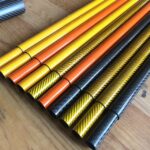Carbon fiber has revolutionized industries such as sports, aerospace, automotive and construction. However, when it comes to choosing the right type of carbon fiber for a particular application, it usually comes down to two main types: pultruded and roll-wrapping. Both of these materials, while derived from carbon fiber, have different manufacturing processes that affect their properties, performance and optimal use.
1. Pultruded Carbon Fiber
What is Pultrusion?
Pultruded carbon fiber is made through a continuous process called pultrusion. In this technique, carbon fiber strands are pulled through a resin bath and then heated and cured in a mold to form a solid shape. The composites thus made have consistent density and strength. The pultrusion process is ideally suited for the production of large quantities of carbon fiber components that require consistency and strength in the final product.
Advantages of Pultruded Carbon Fiber
One of the outstanding features of pultruded carbon fiber is its high strength-to-weight ratio. It is very lightweight, yet can withstand tremendous stress, making it ideal for use in industries such as aerospace and automotive, which have stringent requirements for both strength and weight. In addition, pultruded carbon fiber has excellent dimensional stability, which means it retains its shape and size even under harsh conditions. In addition, the pultrusion process is highly scalable, allowing for cost-effective, high-volume production.
2. Roll Wrapped Carbon Fiber
What is Roll Wrapping?
Unlike pultrusion, roll wrapping is a manual or automated process in which a carbon fiber fabric or tape is wrapped around a die layer by layer. Resin is applied between each layer and the entire structure is then cured to solidify the fibers. Roll wrapping technology allows for greater design flexibility, enabling manufacturers to create complex shapes and components.
Benefits of Roll Wrapped Carbon Fiber
Roll-wrapped carbon fiber is particularly suitable for applications where customization and design flexibility are essential. The material can be precisely molded into complex shapes, making it ideal for aesthetically pleasing or geometrically complex products. In addition, roller wrapping provides a smoother surface, which is often preferred for consumer-oriented products. The process also provides better control of fiber orientation, resulting in special performance characteristics such as increased flexibility.
Common Applications
Common uses of wrapped carbon fiber include
Sporting Goods: Tennis rackets, bicycles and fishing rods.
Consumer Electronics: Customized housings for high-end electronics.
Decorative items: Housings or finishes for high-end products. Roll wrapped carbon fiber produces aesthetically pleasing custom shapes that are ideal for high-end consumer products.


